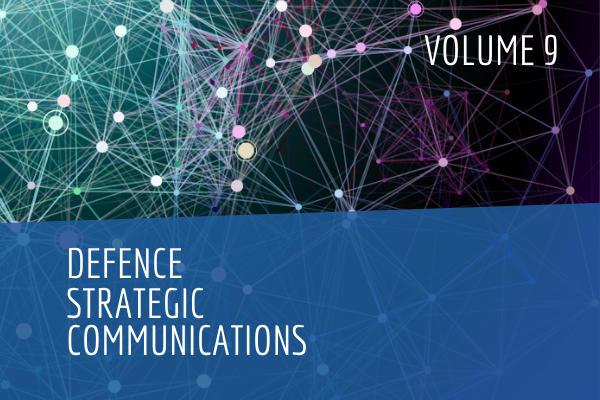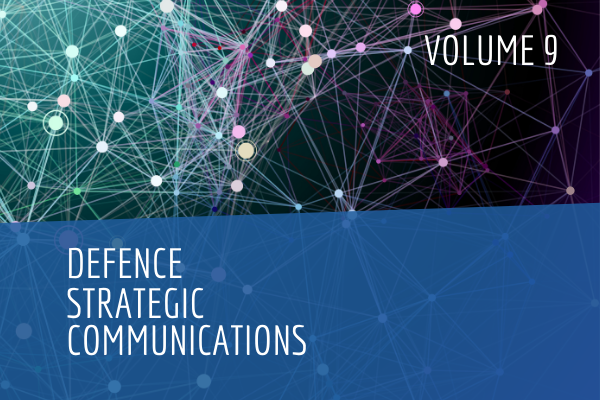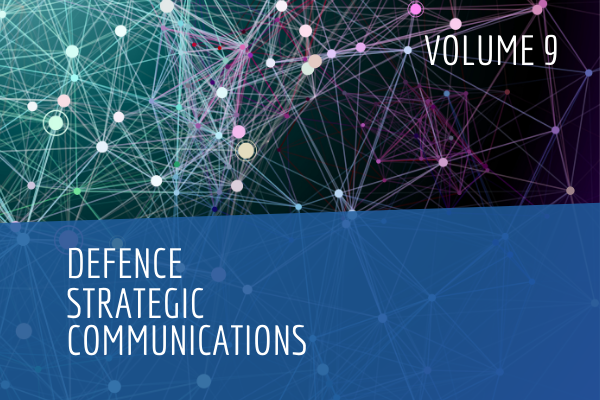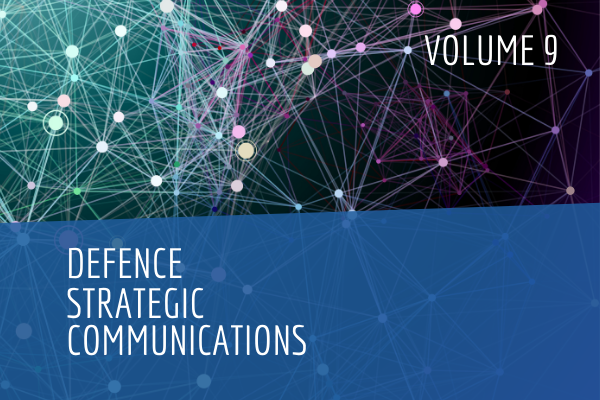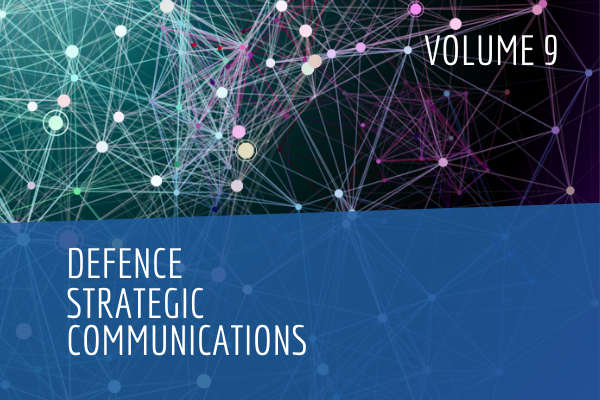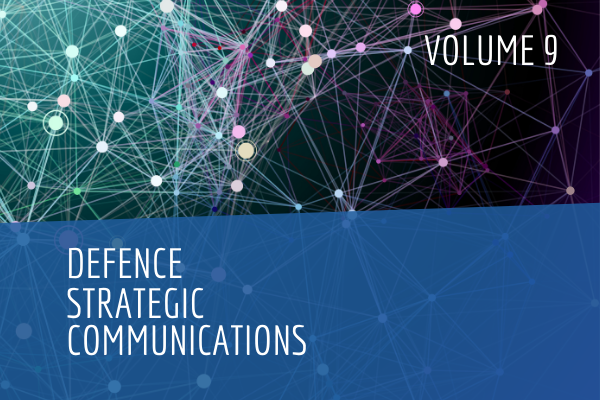Abstract
The Syrian war is the first of the modern Islamist “jihad” conflicts to have attracted large numbers of recruits from Central Asia and the post-Soviet region. Some 9,000 men and women from the post-Soviet republics travelled to Syria, including 4,000-7,000 Central Asians, many of them recruited in Russia. Why did the Islamic State’s caliphate attract such large numbers? Information manipulation was central to IS strategic planning and a primary factor in its unprecedented global recruiting success. IS produced Russian-language media content to build support among post-Soviet Muslims. At the same time, emerging communications networks are building ties between “Russian-speaking” Muslims and the Middle East. Jihadist media engagement in Russian and in Central Asian languages, exploiting these new networks, was a key factor in attracting Central Asians to support the caliphate.
Keywords—strategic communications, strategic communication, Islamic State, violent extremism, radicalism, jihad, disinformation, Central Asia, Caucasus, Russia, post-Soviet.
About the Author:
Ian MacWilliam has been a journalist and media development specialist for over 25 years, including ten years with the BBC and reporting for major British and US newspapers, particularly from the former Soviet region and South Asia. He was based for eight years in Central Asia and Moscow.
BIBLIOGRAPHY
Barrett, Richard, Beyond the Caliphate: Foreign Fighters and the Threat of Returnees (New York: The Soufan Center, October 2017).
Bleuer, Christian, ‘To Syria, not Afghanistan: Central Asian jihadis “neglect” their neighbour’. Afghanistan Analyst Network, 8 October 2014.
Botobekov, Uran, ‘Uzbek’s Katibat al Tawhid wal Jihad changed its leader’, Modern Diplomacy.eu, 19 April 2019.
Callimachi, Rukmini, ‘A News Agency With Scoops Directly From ISIS, and a Veneer of Objectivity’, New York Times, 14 January 2016.
Caucasian Knot website, ‘Эксперты исключили выход кавказских группировок из ИГ после смерти аш-Шишани’ [‘Experts exclude the exit of Caucasian militant groups from ISIS after the death of ash-Shîshânî], 15 July 2016.
Center for Strategic and International Studies (CSIS), ‘Russian-speaking Foreign Fighters in Iraq and Syria: Assessing the Threat from (and to) Central Asia’, (Washington, DC: December 2017).
Cook, Joana and Gina Vale, From Daesh to ‘Diaspora’ II: The Challenges Posed by Women and Minors After the Fall of the Caliphate (London: International Centre for the Study of Radicalisation, 2019).
Counter Extremism Project, ‘Extremist Content Online: ISIS Moves to Hoop Messenger and TamTam Following Telegram Takedowns’, Press release, 10 December 2019.
Elshimi, Mohammed S, with Rafaello Pantucci, Sarah Lain and Nadine L Salman, Understanding the Factors Contributing to Radicalisation Among Central Asian Labour Migrants in Russia (London: RUSI, 2018).
Fainberg, Alisa, Spread the Word: Russia Social Media on the Service of Jihad (Herzliya, Israel: International Institute for Counter-Terrorism, Spring 2017), p. 10.
Fainberg, Alisa and Eitan Azani, Central Asia Jihadism: Home and Abroad (Herzliya, Israel: International Institute for Counter-Terrorism, October 2017), p. 23, note 40.
Fridman, Ofer, Vitaly Kabernik, and James C. Pearce (eds), Hybrid Conflicts and Information Warfare: New Labels, Old Politics (London: Lynne Rienner, 2019).
Gambhir, Harleen, The Virtual Caliphate: ISIS’s Information Warfare (Washington, DC: Institute for the Study of War, 2016).
Heathershaw, John and David W. Montgomery, ‘The Myth of Post-Soviet Muslim Radicalization in the Central Asian Republics’, Russia and Eurasia Programme Meeting Summary (London: Chatham House, November 2014).
Islamic State publications (Raqqa: Al Hayât Media Foundation)
Dabiq, Issues 1–15, 2014–16,
Dar-al-Islam, Issues 9 & 10, 2016
Istok, Issues 1–4, 2015–16,
Rumiyah, Issues 1, 2, 3, 9 & 10, 2016–17.
47 Lakomy, Miron, ‘Cracks in the Online ‘Caliphate’: How the Islamic State is Losing Ground in the Battle for Cyberspace’, Perspectives on Terrorism, Volume 11, № 3 (2017).
Lemon, Edward J., ‘Daesh and Tajikistan: The Regime’s (In)Security Policy’, The RUSI Journal Volume 160, № 5 (2015): 68–76.
Lemon, Edward, ‘The Varied Roads from Central Asia to the Islamic State’, Impakter.com, 28 February 2017.
Lemon, Edward, Vera Mironova, and William Tobey, Jihadists from Ex-Soviet Central Asia: Where Are They? Why Did They Radicalize? What Next? (Cambridge, Massachusetts: Russia Matters, December 2018).
Lomas, Natasha, ‘Tech Giants Told to Remove Extremist Content Much Faster’, TechCrunch, 20 September 2017.
Matveeva, Anna, ‘Radicalisation and Violent Extremism in Kyrgyzstan’, The RUSI Journal Volume 163, № 1 (February/March 2018): 30–46.
Matveeva, Anna and Antonio Giustozzi, ‘The Central Asian Militants: Cannon Fodder of Global Jihadism or Revolutionary Vanguard?’, Small Wars & Insurgencies Volume 29 № 2 (2018): 189–206.
McDonald, Kevin, Radicalization (Cambridge: Polity Press, 2018).
Milton, Daniel, Communication Breakdown: Unraveling the Islamic State’s Media Efforts (West Point: US Military Academy Combating Terrorism Center, October 2016).
Mironova, Vera, ‘The New Face of Terrorism in 2019’, Foreign Policy, 1 January 2019.
Mironova, Vera, Ekaterina Sergatskova and Karam Alhamad, ‘The Lives of Foreign Fighters Who Left ISIS’, Foreign Affairs, 27 October 2017.
Nasritdinov, Emil, ‘Vulnerability of Labor Migrants from Kyrgyzstan to Engagement with Violent Extremist Groups in Russian Federation’ (Bishkek: United Nations Development Program, 2016)
Nasritdinov, Emil, Zarina Urmanbetova, Kanatbek Murzakhalilov and Mametbek Myrzabaev, ‘Vulnerability and Resilience of Young People in Kyrgyzstan to Radicalization, Violence and Extremism: Analysis Across Five Domains’, CAP paper, № 213 (Washington: George Washington University, January 2019).
Naumkin, Vitaly V., Radical Islam in Central Asia; Between Pen and Rifle (Oxford: Rowman & Littlefield, 2005).
Olimova, Saodat, ‘Угроза радикализации в странах Центральной Азии: социальное измерение (на примере Республики Таджикистан)’ [‘Threat of Radicalisation in the Countries of Central Asia: Social Dimensions (Example of the Republic of Tajikistan)’] Central Asian Analytical Network, 2015.
Paraszczuk, Joanna, ‘Have Tajik IS Militants Faked Their Own “Martyrdoms”?’, Radio Free Europe/Radio Liberty (RFE/RL), 1 July 2015.
Paraszczuk, Joanna, ‘“IS Babies”—The Chilling New Trend Among Islamic State Militants’, RFE/RL, 19 July 2015.
_______, ‘IS Boosts Russian-Language Propaganda Efforts’, RFE/RL, 6 July 2015.
_______, ‘IS Central Asian Recruitment Drive a Family Affair’, RFE/RL, 5 April 2016.
_______, ‘“Leave Nusra, Join IS”, Uzbek Militant Urges In New IS Video’, RFE/RL, 20 June 2015.
_______, ‘Main Uzbek Militant Faction in Syria Swears Loyalty To Taliban’, RFE/RL, 12 November 2014.
_______, ‘Uzbeks Arrested For Allegedly Trying To Join Al-Qaeda Group In Syria’, RFE/RL, 6 November 2015.
Phillips, Vaughan, ‘The Islamic State’s Strategy: Bureaucratizing the Apocalypse through Strategic Communications’, Studies in Conflict & Terrorism Volume 40 № 9 (2017): 731–57.
Radio Azattyk, ‘«150 казахских джихадистов в Сирии» взорвали социальные сети’ [“150 Kazakh Jihadists” Shake Up Social Media], Radio Free Europe/Radio Liberty Kazakh Service, 21 October 2013.
49 Rashid, Ahmed, Jihad: The Rise of Militant Islam in Central Asia (New Haven: Yale University Press, 2002).
Staff, ‘Isis admits “minister for war” Omar the Chechen is dead’, The Guardian, 13 July 2016.
Staff, ‘Вербовка узбеков в ряды ИГ все чаще происходит в «Одноклассниках»’ [‘IS Recruitment of Uzbeks happens increasingly on “Odnoklassniki”’], Radio Free Europe/ Radio Liberty Uzbek Service, 11 June 2015.
Tan, Rebecca, ‘“Terrorists” Love for Telegram, Explained’, Vox, 30 June 2017.
Tucker, Noah, ‘Islamic State Messaging to Central Asian Migrant Workers in Russia’, CERIA Brief № 6, Central Asia Program, George Washington University, February 2015.
_______, ‘Public and State Responses to ISIS Messaging: Kazakhstan’, CERIA Brief № 13, Central Asia Program, George Washington University, February 2016.
_______, ‘Public and State Responses to ISIS Messaging: Kyrgyzstan’, CERIA Brief № 14, Central Asia Program, George Washington University, February 2016.
_______, ‘Public and State Responses to ISIS Messaging: Tajikistan’, CERIA Brief № 11, Central Asia Program, George Washington University, February 2016.
_______, ‘Public and State Responses to ISIS Messaging: Uzbekistan’, CERIA Brief № 12, Central Asia Program, George Washington University, February 2016.
_______, ‘Research Note: Uzbek Online Recruiting to the Syrian Conflict’, CERIA Brief № 3, Central Asia Program, George Washington University, November 2014.
_______, ‘What Happens When Your Town Becomes an ISIS Recruiting Ground? Lessons from Central Asia about Vulnerability, Resistance, and the Danger of Ignoring Perceived Injustice’, Central Asia Program Paper № 209, George Washington University, July 2018.
Tucker, Noah and Rana Turaeva, ‘Public and State Responses to ISIS Messaging: Turkmenistan’, CERIA Brief № 15, Central Asia Program, George Washington University, February 2016.
Tucker, Noah, Edward Lemon, and Alex Zito, Central Asia Secure and Stable States: Identifying Communities Vulnerable to Mobilization to Violent Extremism in Central Asia, Navanti internal report, 11 March 2019.
Violent Extremism in Central Asia 2018: A preliminary survey of groups, digital dimensions and state responses, The SecDev Group (Ottawa) and Public Foundation Civil Initiative on Internet Policy (Bishkek), 2018.
Weiss, Caleb, ‘Al Qaeda affiliated Uzbek leader assassinated in Syria’, Long War Journal, 30 April 2017.
Winter, Charlie. ‘Media Jihad: The Islamic State’s Doctrine for Information Warfare’, London: International Centre for the Study of Radicalization (ICSR), 2017.
_______, ‘The Battle for Mosul: An Analysis of Islamic State Propaganda’ in Fridman et al. (eds), Hybrid Conflicts, p. 171–190.
Yarlykapov, Akhmet, ‘Divisions and Unity of the Novy Urengoy Muslim Community’, Problems of Post-Communism, 2019. Article published online 20 August 2019, p. 6.
_______, ‘Islamic State propaganda in the North Caucasus’ in Fridman et al. (eds), Hybrid Conflicts, p. 213–224.
Yemelianova, Galina (ed.), Radical Islam in the Former Soviet Union (London: Routledge, 2010).
Zelin, Aaron Y., ‘Picture or It Didn’t Happen: A Snapshot of the Islamic State’s Official Media Output’, Perspectives on Terrorism Volume 9, № 4 (2015): 85–97.
WEBSITES
Caucasian Knot [Кавказский Узел] <https://www.kavkaz-uzel.eu> News website focusing on the Caucasus.
51 Chechens in Syria <http://www.chechensinsyria.com> Managed by Joanna Paraszczuk.
Counter Extremism Project <https://www.counterextremism.com> Khalimov entry: <https://www.counterextremism.com/extremists/gulmurod-khalimov>
Islamic State videos (most accessible on Jihadology.net):
Al Furqan Media Centre:
Clanging of the Swords, Part 4.
Al Furat Media Centre:
Apostates Killed: Revenge for the Monotheists.
Caravan of Martyrs 2: Abu ‘Abd al ‘Aziz ash-Shishani [Караван Шахидов 2: Абу Абдульазиз Шишани].
Caravan of Martyrs 3: Abu Hudhayfah al-Daghistani [Караван Шахидов 3: Абу Хузейфа Дагестани].
Completely Bankrupt [Полный Банкрот].
Council of the Commanders of the Mujahidin in the Caucasus Province [Собрание Амиров Муджахидов Вилаята Кавказ].
Message from an Officer of the Russian FSB captured by the Islamic State to the President and People of Russia [Обращение Офнцера ФСБ РФ плененного Исламским Государством к президенту и народу России].
Message to the People of Kyrgyzstan [Послание Народу Киргизий]
The Right Word, from the Shores of the Tigris [Справое Слово с Берегов Тигра].
Surgut: Blood for Blood [Сургут: Кровь за Кровь].
Jihadology <https://jihadology.net/> Archive of Islamist media content managed by Aaron Y. Zelin.
UN Security Council Sanctions List <https://www.un.org/securitycouncil/sanctions/1267/aq_sanctions_list>
Atabiev entry: <https://www.un.org/securitycouncil/sanctions/1267/aq_ sanctions_list/summaries/individual/islam-seit-umarovich-atabiev>
